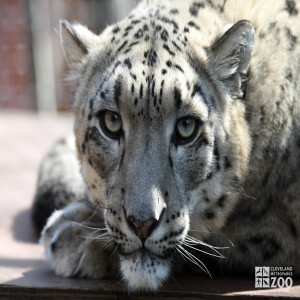Snow Leopard
[Panthera uncia]

Snow leopards have a head and body length of about 39.25 to 51.25 inches and a tail length of 31.5 to 39.25 inches. They weight between 55 to 165 pounds with most weighing under 110 lbs. Snow leopards have gray-green eyes and long, thick fur, pale gray to olive in coloration, and patterned with large dark rosettes and spots.The coat has a woolly-like undercoat. They are slightly smaller than the common spotted leopard. The tail, nearly as long as the body, is important for maintaining balance. The large paws act as snow shoes. The strong claws and large pads separated by hairy zones enable them to walk with ease on rugged mountainous terrain without sinking into the snow.
Snow leopards are solitary cats, though not unsocial. They exhibit a distinct preference for traveling along major ridges, river bluffs or cliffs, and other well-defined landscape “edges”. These crepuscular cats like to rest in places with good vistas, such as cliff ledges. These agile cats have been observed to jump 45 feet in a single leap.
Snow leopards are highly endangered in the wild. They are being bred in captivity under the guidance of the Species Survival Plan (SSP) developed by the American Zoo and Aquarium Association (AZA).
Location: Asian Highlands
Share:
Range
Mountainous regions of Central Asia, including Russia, China, Mongolia, Nepal, Bhutan, India, Pakistan, and Afghanistan.
Habitat
Snow leopards inhabit steep, rugged terrain at high elevations.
Conservation Status
VulnerablePrimary Threats
Human Wildlife Coexistence, Climate ChangeGestation
Gestation lasts between 90 to 103 days.
Litter
1-5
Behavior
Snow leopards are solitary cats, though not unsocial. While pairs have been seen hunting together, it is not known if they were male and female or mother and offspring. Females’ ranges are separate but males’ territory may overlap the ranges of females or other males, though duplicate use is separated by time. They do not appear to patrol the boundaries of their home ranges, although they visit most parts at least every two weeks. They exhibit a distinct preference for traveling along major ridges, river bluffs or cliffs, and other well-defined landscape “edges”. These crepuscular cats like to rest in places with good vistas, such as cliff ledges. In areas where they are persecuted for their pelts they tend to be nocturnal. These agile cats have been observed to jump 45 feet in a single leap. They are very slow eaters. They appear to prefer to kill male ungulates (the larger horns make them easier to unbalance). They attack from uphill, as ungulates appear to watch downhill. They are one of the four species of large cats (tigers, clouded leopards, snow leopards and jaguars) which use the “prusten” noise. This is best known in tigers – a throaty exhalation.
Reproduction
The mating season for snow leopards is January through March. Births occur from April to June. The cubs’ eyes open after 7 days and they eat their first solid food when they are about 2 months old. They begin to follow their mother when she goes hunting about a month later. They probably leave their natal range at about 2 years. The young are usually born in a rocky shelter lined with their mother’s fur. They hunt with their mother at least through the first winter. Sexual maturity is attained at 2 years.
Wild Diet
Blue sheep, marmots, ibex, musk deer, pika, markhor, hare, birds, and vegetation



